-
Paper Information
- Next Paper
- Previous Paper
- Paper Submission
-
Journal Information
- About This Journal
- Editorial Board
- Current Issue
- Archive
- Author Guidelines
- Contact Us
Archaeology
p-ISSN: 2332-838X e-ISSN: 2332-841X
2021; 9(1): 7-13
doi:10.5923/j.archaeology.20210901.02

Non-Destructive XRF and Raman Spectroscopy Analysis in Pigment Identification of a Wall Painting of the Painter Nikiforos Lytras from the Chapel of Agios Georgios, Haidari, Athens
Eirini Christopoulou, Theodoros Ganetsos, Nikolaos Laskaris
Department of Industrial Design and Production Engineering, University of West Attica, Egaleo, Athens, Greece
Correspondence to: Eirini Christopoulou, Department of Industrial Design and Production Engineering, University of West Attica, Egaleo, Athens, Greece.
| Email: |  |
Copyright © 2021 The Author(s). Published by Scientific & Academic Publishing.
This work is licensed under the Creative Commons Attribution International License (CC BY).
http://creativecommons.org/licenses/by/4.0/

The church of Agios Georgios which is dated in 16th century by the post-byzantine wall painting of Humiliation at the niche of Intention in the Sanctuary that is dated in that period, is famous for the wall paintings which decorate multiple points of the church’s interior. All these wall paintings are dated in the second half of 19th century and two of them were painted with certainty by the painter Nikiforos Lytras maybe in collaboration with Nikolaos Gyzis [1], while the rest of them are probably works of the same artist too. It is about the two wall paintings of Nikiforos Lytras which are situated in the north and the south wall with representations of the Beheading of John the Baptist and Saint George on horseback killing the dragon, three wall paintings situated in the iconostasion of the temple with representations of Jesus Christ, Virgin Mary and Saint Paraskevi and the wall painting of the niche of the sanctuary with the representation of Platytera (Virgin Mary holding Jesus Christ child with hands in a pleading position) which probably is painted by the painter Nikiforos Lytras maybe in collaboration with the painter Nikolaos Gyzis [2]. The present study is focused on the wall painting of Platytera at the niche of the sanctuary of the church of Agios Georgios (19th century) and is part of doctoral thesis with subject ‘‘Application of non- destructive spectroscopic techniques for pigments identification and reconstruction of the colour pallet in Nikiforos Lytras and Nikolaos Gyzis paintings’’. For the purpose of this study were carried out in-situ measurements using non-destructive pXRF and pRaman spectroscopic techniques in order to identify the pigments. The results of this study which are extracted based on the collaboration of the two techniques, are of high importance since they are compared with pigments of that period and pigments of other paintings of the same painter in order to fruitful conclusions are drawn as to whether the work was created by Nikiforos Lytras in collaboration with Nikolaos Gyzis, as reported, or not.
Keywords: XRF spectroscopy, Raman spectroscopy, Nikiforos Lytras, Nikolaos Gyzis
Cite this paper: Eirini Christopoulou, Theodoros Ganetsos, Nikolaos Laskaris, Non-Destructive XRF and Raman Spectroscopy Analysis in Pigment Identification of a Wall Painting of the Painter Nikiforos Lytras from the Chapel of Agios Georgios, Haidari, Athens, Archaeology, Vol. 9 No. 1, 2021, pp. 7-13. doi: 10.5923/j.archaeology.20210901.02.
Article Outline
1. Introduction
- The chapel of Agios Georgios, which is situated in Haidari, Athens used to belong at Haidari property, which was Nikolaos Nazos property. Nikolaos Nazos was a banker and an art enthusiast from Tinos, Cyclades, who lived in Palataki Tower at Haidari. According to N. Lytras, born at Pyrgos, Tinos in 1832, after his subscription to the School of Arts of Athens in 1850, become very requested as a painter [3]. The same period meets N. Nazos, who asked him to paint the interior of Agios Georgios in Haidari. Apart from that, he accommodates the great painters of Greek art of 19th century, Nikiforos Lytras and Nikolaos Gyzis, both from Tinos, in the guest room of the Tower after 1850 [2]. The chapel of Agios Georgios is famous for the wall paintings, which decorate multiple points of the church’s interior. Two of those wall paintings which decorate the chapel’s interior were created with certainty by the famous painter Nikiforos Lytras maybe in collaboration with Nikolaos Gyzis, but N. Lytras had the main responsibility of the artwork. Moreover, the wedding ceremony of N. Gyzis with Artemis Nazou, daughter of Nikolaos Nazos, was placed there in 24th of April 1876 [1].Another one of those paintings, the one with the representation of the Humiliation of Jesus Christ, which decorates the niche of Intention in the sanctuary of the chapel, dates the chapel in the 16th century or earlier [4].The reason of our visit in the chapel was the two wall paintings, which are situated in the north and the south wall, next to the decorative panel (iconostasion) of the temple that they were painted with certainty by N. Lytras in the 2nd half of 19th century A.D. maybe in collaboration with Nikolaos Gyzis. It is about wall paintings with the representations of the Beheading of John the [5] Baptist in the north wall and the Saint George on horseback killing the dragon on the south wall [5], both in a very bad condition because of timeworn and over painting. Remains of rich colors of red, ochre and brown are only distinguished. Despite that we visit the chapel in order to take measurements in the above two wall paintings, we met many difficulties during the measurements since there were a protective glass between the wall painting and our equipment, which made our results precarious.Furthermore, there are three more wall paintings which decorate the decorative panel (iconostasion) in the interior of the chapel. It is about wall paintings with representations of Agia Paraskevi, Jesus Christ and Virgin Mary. All figures are depicted in an upright position [4]. The work of cleaning these wall paintings was undertaken by National Gallery of Athens, which estimated that these works also belong to the painters N. Lytras and N. Gyzis, as reported in in-situ information label above the wall paintings. However, because of their bad condition the painter identification is precarious.Exploring the chapels interior and after the suggestion of the priest of the chapel who informed us that there are another wall painting of N. Lytras in the interior of the chapel, we decided to collect information about that wall painting. It is about the wall painting of Platytera i.e. Virgin Mary holding Jesus Christ as a child, which is believed that it was painted by N. Lytras at the 2nd half of 19th century A.D., as it is referred on in situ label. That wall painting decorates the niche of the sanctuary of the chapel and it is possible creation of N. Lytras because, according to sources the painter has worked on religious paintings, and especially on the subject of Platytera repeatedly. Specifically, he had presented a portable icon of Platytera at the Universal Exhibition of Art in Paris at 1855, which now is lost [6]. Lytra's works are divided into genre painting, historical compositions, landscapes, allegories and portraits. He also painted hagiographies but not in the Greek or Byzantine way. He mainly loved the themes from the daily life of the people. His works until the end of his life (1904) are influenced by the art of his teacher Karl von Piloty and German academic realism in general, from the time he was a student at the Munich School. Even in hagiographies he is deeply influenced by the German painting style. On the contrary, the style and atmosphere of his historical and ethnographic compositions are strongly reminiscent of Greece [3].
2. Materials and Methodology
2.1. Research Aims
- The present study is focused on the wall painting of Platytera at the niche of the Sanctuary of the chapel of Agios Georgios, Haidari and is part of doctoral thesis with subject “Application of non-destructive spectroscopic techniques for pigments identification and reconstruction of the color pallet in N. Lytras and N. Gyzis paintings’’. This study aimed at the pigment identification of wall painting of Platytera which is situated in the niche of the sanctuary of Agios Georgios chapel, Haidari, Athens. Results are of high importance for the ascertainment of the color pallet, material and construction techniques of wall paintings of the 2nd half of 19th century. A further aim of this study is the identification of the pigments used by the two great painters of the 2nd half of the 19th century, Nikiforos Lytras and Nikolaos Gyzis [7]. For all measurements, a formal permission was given to us by the ephorate of West Attica in Athens.
2.2. Materials
- The historical chapel of Agios Georgios is situated at the beginning of the road Rimini in Haidari, Athens. It was the cemetery of Haidari until 1970 [4]. The wall painting of Humiliation of Jesus Christ at the niche of Intention dates the chapel at 16th century. In this chapel the great painter Nikiforos Lytras create two wall paintings for certainty and maybe another four. Also, the other great painter Nikolaos Gyzis married his wife Artemis Nazou there, in 1876.
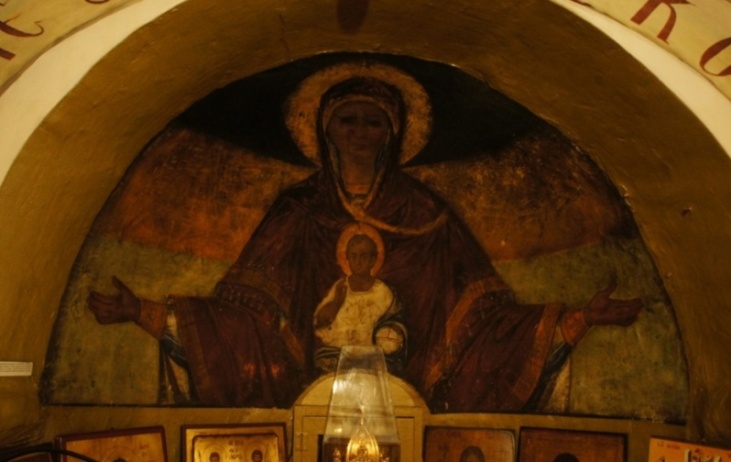 | Figure 1. The wall painting of Platytera in the niche of the sanctuary of Agios Georgios, Haidari, Athens |
2.3. Methodology
- For this study were carried out in-situ measurements using portable and non-destructive p XRF and p Raman spectroscopic techniques in order to identify the pigments which were used by the painter. A portable spectrometer was used to perform the measurements in the wall painting of Platytera for the present study. Specifically, it is used the Rock Hound 785nm of Delta Nu which has a built in color camera and digital microscope with a resolution of 10cm-1. The wavelength of the laser is 785nm and the size laser beam is 35 μm. Subsequently, a second X-ray fluorescence spectroscopy (XRF) was performed at the same sites as the Raman [7]. The measurements were performed with the help of the portable hand-held X-ray fluorescence spectrometer. Specifically, a Thermo Scientific Niton XLp XRF Analyzer with a high performing and solid-state detector was used. The experimental results were extracted based on the correlation of the two non-destructive, complementary techniques of p XRF and p Raman spectroscopy and their results were compared with pigments of the same period of 19th century as the wall painting of Platytera is dated [8]. All XRF and Raman spectra analysis was carried out with the help of scientific software Spectragryph (F. Menges ‘‘Spectragryph – optical spectroscopy software’’, version 1.2.14, 2020). All measured Raman spectra, before the main process of pigment identification were subjected to a pre-processing procedure such as baseline correction, Savitzky-Golay smoothing and normalization (9).
3. Results and Discussion
- In figure 2 the sampling points for each color hue are presented (dark red dots). The colors which were selected for measurements from the wall painting are the following: Yellow, blue, white, greenish white, black, flesh hue and brownish red. The measurement points on the wall painting of Platytera are the following: yellow from Christ and Virgin Mary halo and the middle part of background, blue from Virgin Mary’s sleeve, brownish red from Virgin Mary’s garment, flesh hue from Virgin Mary’s hand and neck, white from Christ’s garment, greenish white from the lower part of the background and black from the upper part of background in the roof.
 | Figure 2. The wall painting of Platytera. Red dots are the spots were XRF and Raman measurements applied |
 | Figure 3. Points of measurements in microscope view |
|
 | Figure 4. Flesh hue of Platytera (blue line) in comparison with reference spectrum of Goethite (dark yellow line) |
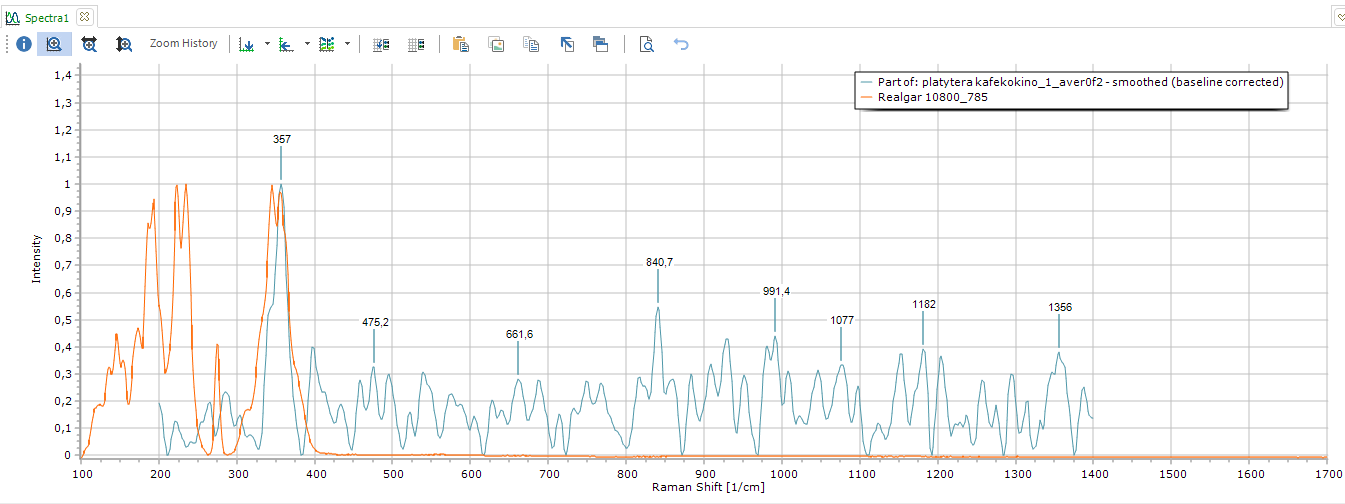 | Figure 5. Brownish red of Platytera (blue line) in comparison with Realgar reference spectrum (orange line) |
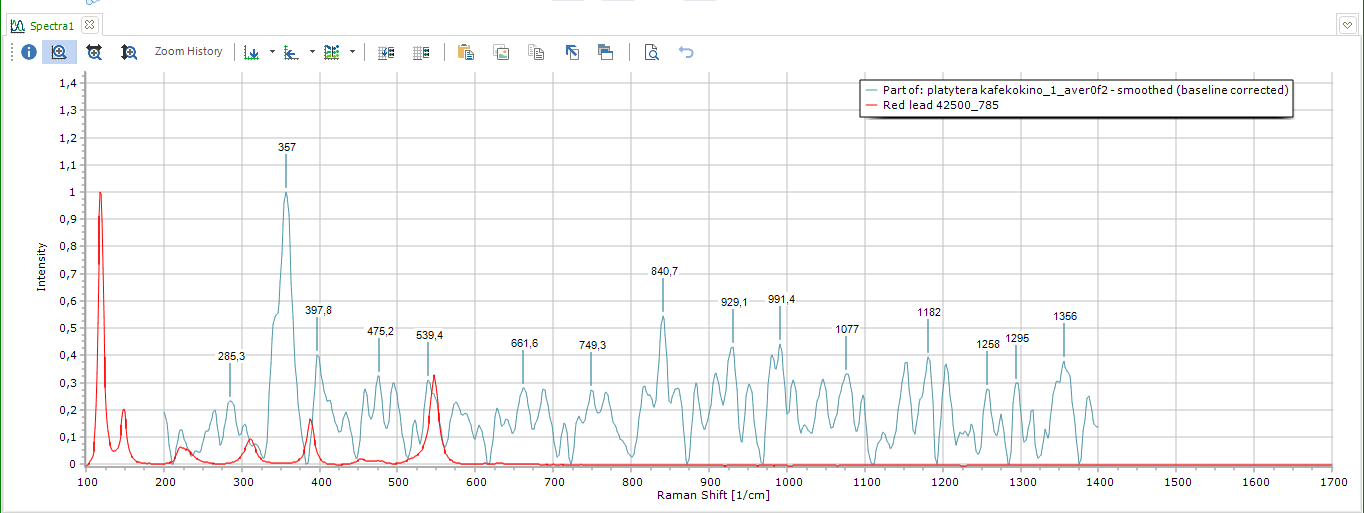 | Figure 6. Brownish red of Platytera (blue line) in comparison with Red Lead reference spectrum (red line) |
 | Figure 7. Flesh hue of Platytera (blue line) in comparison with Burnt Sienna reference spectrum (brown line) |
 | Figure 8. Blue of Platytera (blue line) in comparison with Cobalt blue reference spectrum (dark blue line) |
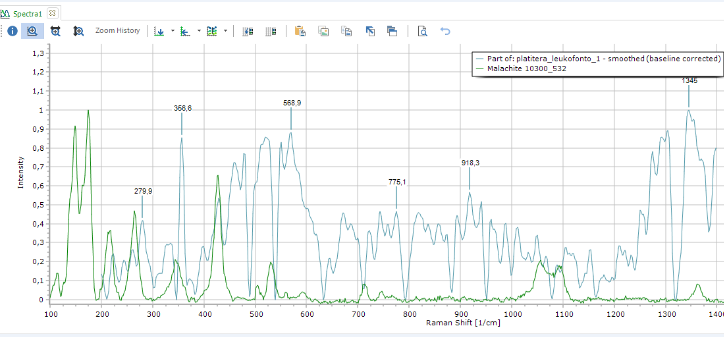 | Figure 9. Greenish white of Platytera (blue line) in comparison with Malachite reference spectrum (green line) |
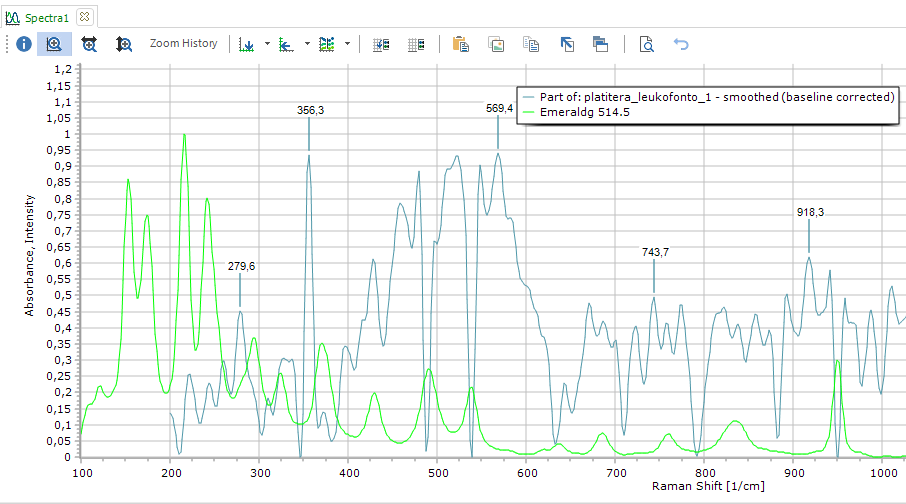 | Figure 10. Greenish white of Platytera (blue line) in comparison with Emerald Green reference spectrum (green line) |
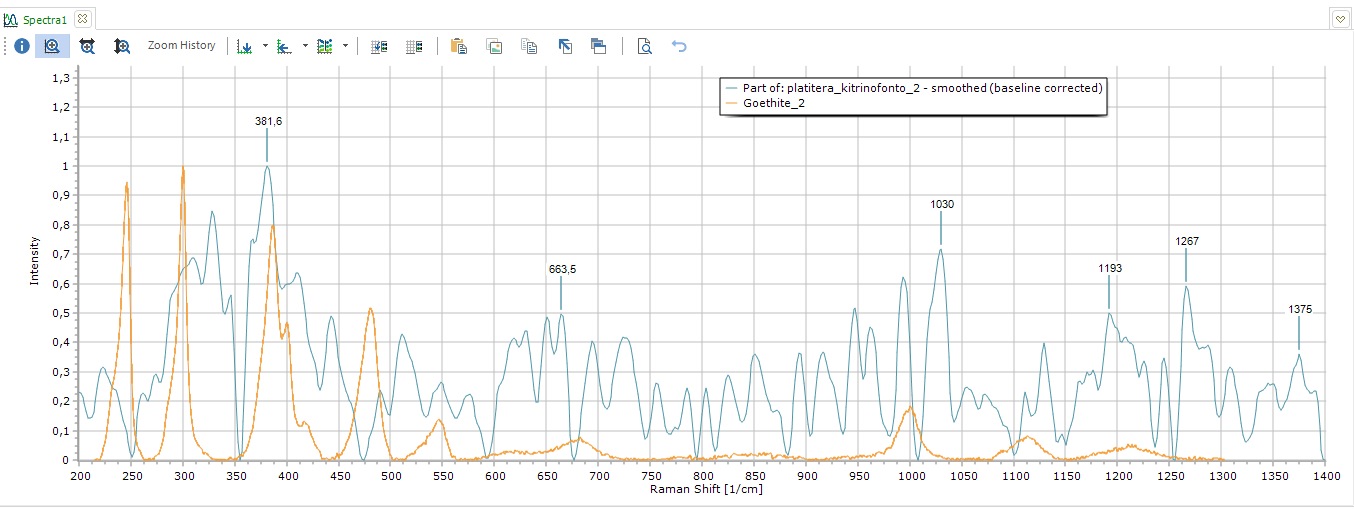 | Figure 11. Yellow of Platytera (blue line) in comparison with Goethite reference spectrum (dark yellow line) |
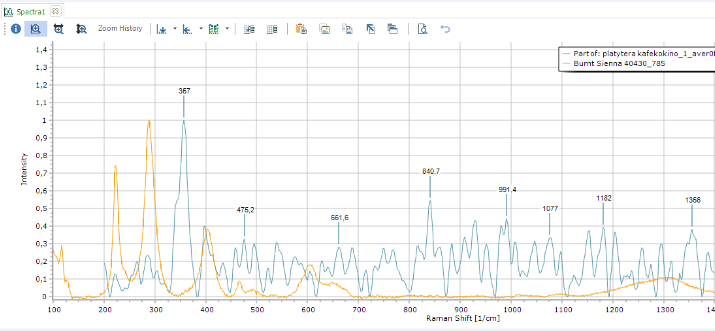 | Figure 12. Brownish red of Platytera (blue line) in comparison with Burnt Sienna reference spectrum (dark yellow line) |
4. Conclusions
- This study aimed at the pigment identification of the wall painting of Platytera of the painter Nikiforos Lytras which is situated in the chapel of Agios Georgios, Haidari, Athens. Summarizing the results, painter Nikiforos Lytras used Goethite, Burnt Sienna, Red Lead and Realgar for the yellow, orange (flesh hue) and brownish red colors, Cobalt Blue for the blue color, Malachite or Emerald Green for the green color and White Lead for the white color.As the research for the aforementioned painters’ work continues, the present results will be compared with pigments of painters’ other paintings in order to draw fruitful conclusions regarding whether the present work was created by N. Lytras in collaboration with N. Gyzis, as reported, or not.
ACKNOWLEDGEMENTS
- The director of West Attica Ephorate of Antiquities is sincerely thanked for the permission of measurements. Finally, the authors are grateful to priest Christos, responsible of the chapel of Agios Georgios, Haidari, Athens for his help.
 Abstract
Abstract Reference
Reference Full-Text PDF
Full-Text PDF Full-text HTML
Full-text HTML